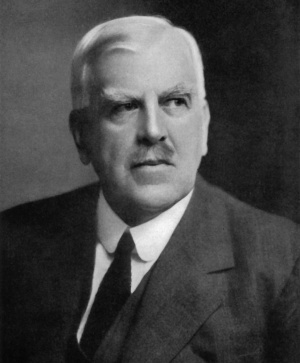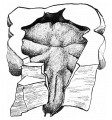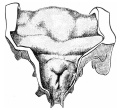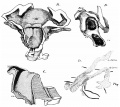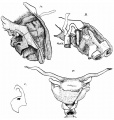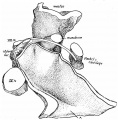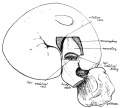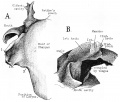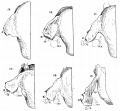Embryology History - Ernest Frazer
| Embryology - 27 Apr 2024 |
|---|
| Google Translate - select your language from the list shown below (this will open a new external page) |
|
العربية | català | 中文 | 中國傳統的 | français | Deutsche | עִברִית | हिंदी | bahasa Indonesia | italiano | 日本語 | 한국어 | မြန်မာ | Pilipino | Polskie | português | ਪੰਜਾਬੀ ਦੇ | Română | русский | Español | Swahili | Svensk | ไทย | Türkçe | اردو | ייִדיש | Tiếng Việt These external translations are automated and may not be accurate. (More? About Translations) |
John Ernest Sullivan Frazer
John Ernest Sullivan Frazer (1870-1946) began as a Lecturer on Anatomy in the Medical School of St Mary’s Hospital, then Senior Demonstrator in the Anatomical Departmnent, King's College and then Professor of Anatomy in the University of London.
He wrote on several embryology and anatomy topics, as well as publishing an embryology textbook (A Manual of Embryology 1931,1940).
Human embryos from his collection were also used in a number of other published studies.[1]
| Embryologists: William Hunter | Wilhelm Roux | Caspar Wolff | Wilhelm His | Oscar Hertwig | Julius Kollmann | Hans Spemann | Francis Balfour | Charles Minot | Ambrosius Hubrecht | Charles Bardeen | Franz Keibel | Franklin Mall | Florence Sabin | George Streeter | George Corner | James Hill | Jan Florian | Thomas Bryce | Thomas Morgan | Ernest Frazer | Francisco Orts-Llorca | José Doménech Mateu | Frederic Lewis | Arthur Meyer | Robert Meyer | Erich Blechschmidt | Klaus Hinrichsen | Hideo Nishimura | Arthur Hertig | John Rock | Viktor Hamburger | Mary Lyon | Nicole Le Douarin | Robert Winston | Fabiola Müller | Ronan O'Rahilly | Robert Edwards | John Gurdon | Shinya Yamanaka | Embryology History | Category:People | ||
|
Frazer JE. Development of the larynx. (1910) J Anat. 44: 156-191. PMID 17232839
- Embryonic Larynx Development
Modern Notes: pharyngeal arch
Frazer JE. Pharyngeal end of Rathke's pouch. (1911) J Anat. 45: 190-196. PMID 17232879
Frazer JE. A preliminary communication on the formation of the nasal cavities.(1911) J Anat. 45(4): 347–356. PMID 17232894
Frazer JE. The second visceral arch and groove in the tubo-tympanic region. (1914) J Anat Physiol. 48(4): 391-408. PMID 17233005
- Second Pharyngeal Arch
Modern Notes: pharyngeal arch
Frazer JE. and Robbins RH. On the factors concerned in causing rotation of the intestine in man. (1915) J Anat. 50(1): 75-110. PMID 17233053
- Intestine Development
Modern Notes: intestine
Frazer JE. The early formations of the middle ear and eustachian tube - a criticism. (1922) J Anat. 57(1): 18-30. PMID 17103958
- “Middle
Modern Notes: middle ear
In Memoriam - John Ernest Sullivan Frazer (1870-1946)
“John Ernest Sullivan Frazer.” Journal of Anatomy 80.Pt 3 (1946): 168–169. PMC1272727
D.Sc., F.R.C.S. Emeritus Professor of Anatomy in the University of London
The passing of Prof. J. E. S. Frazer removes one more of the great figures of the older generation of anatomists. Unfortunately, he had been unable for the past nine years to take the same active part as before in anatomical proceedings, owing to the serious illness which seized him suddenly while in the full vigour of his activities. Since that time he had had to restrict himself to less onerous work, such as the revision of his publications, but he retained throughout his interest in the subject which had been his life’s occupation.
Frazer was born in London in 1870, and was educated at Dulwich College. In his early years he had considered following the profession of art, for which he showed some inclination and aptitude. The project was discarded in favour of his other leaning, which was towards medicine, and on leaving school he entered St Bartholomew’s Hospital, from which he qualified at the early age of 21. Valuable practical experience was gained by’ a number of medical and surgical appointments during the period which followed. In particular, he was for some years at the Ventnor Hospital, where he learned much about the medicine and surgery of the chest. He took the F.R.C.S. in 1895, intending to become a surgeon, but a severe post-mortem wound, which for a time threatened his life, caused him to give up this idea, and to make the studyof anatomy, which had attracted him always, the primary focus of his career, instead of a subsidiary subject. He obtained a demonstratorship at St
George’s Hospital, and in 1905 went to King’s College, where he worked with Peter Thompson. In 1911 the Medical School at St Mary’s was undergoing a change which, in the event, was the beginning of his long association with that Hospital. The authorities decided to fall in line with the other schools, and to appoint a full-time lecturer in Anatomy. Up to that time the surgeons had the responsibility of providing lectures and demonstrations, and there was no full-time teacher in the department. Frazer was appointed to the post, and became the first full-time lecturer in Anatomy.
It was uphill work, owing to the meagre accommodation and facilities available in the dilapidated old building which constituted at that time the Medical School. His room consisted of a tiny partitioned-off portion of the dissecting room, and contained neither water nor gas, both of which had to be obtained in other parts of the main room. In 1914 he was appointed Professor in the University of London, and a room was then found for him on the floor below. But it was not until 1932 that suitable accommodation was provided by the erection of the present building. In spite of these difficulties he was able at once to give proof of his great ability both in teaching and in research.
As a teacher he compelled the interest of his hearers by his enthusiasm and by his direct informal style. His gift of pictorial illustration assisted considerably. He would build up a region on the blackboard, superimposing the structures step by step. In addition he used full-sized coloured drawings, in which, owing to his skill in light and shade, the details were clearly visible even in the back rows, a reminder of his early artistic bent. Topographical anatomy, although not holding first place, had a great fascination for him. At one time he even contemplated writing a book on relations, and actually made a start, but came to the conclusion that the difficulty of keeping its scope within reasonable limits made it impracticable. He was wont to insist that what appeared to be a minor detail might at any time constitute a determining factor in the diagnosis of an obscure case, and would give personal experiences in support of his contention.
But it was in the field of embryology that he showed his great powers of careful and thorough investigation. He was constantly preparing and examining specimens of different ages, since, as far as possible, he liked to base his opinions on personal observation. As in topographical anatomy also, his golden rule for clearing up any doubtful point was that one should get hold of the necessary material and see for oneself.
But he also paid due attention to the work of others, assessing it according to the degree to which, after reading the original papers, he considered they proved their case. His memory was extraordinary; he would give the gist of a contribution he had read ten years or more previously, naming the journal, the author, and the approximate date. One felt that any judgement he formed was with full knowledge of all important contributions to the subject.
His own researches included portions of all the systems of the growing embryo, his work on the pharynx, larynx, and tubo-tympanic region being especially notable. The period covered by this investigation was 1910-14, when papers were published on ‘The development of the larynx (1910)[2], ‘ Development of the nasal cartilages’ (1911), and ‘The second visceral arch and groove in the tubo-tympanic region ’ (1914)[3]. A further paper on the ‘Early formation of the middle ear and Eustachian tube’ appeared in 1923.
The septation of the heart engaged his attention at another time, particularly that of the difficult ventriculo-bulbar region. He formulated his conclusions in ‘ The formation of the pars membranacea septi’ (1917). Another region which attracted him on account of its obscurity was‘ the mid-brain, on which he made some very intriguing observations in ‘The development of the region of the isthmus rhombencephali ’ ( 1929)[4].
Other contributions to embryology were: ‘The derivation of the hypothenar muscles’ (1908); ‘The formation of the duodenal curve (1919)[5] ; ‘The disappearance of the pre-cervical sinus ’ (1927), and, with a collaborator, ‘Factors concerned in the rotation of the intestine’ (1916)[6] and ‘The development of the lower end of the vagina’ (1928).
In addition he produced several books. His Anatomy of the Human Skeleton showed his wizardry in making the dry bones live. It has reached a fourth edition and has travelled to all parts of the world. His Manual of Embryology[7] is the record of his own researches over a period of 25 years. It comprises not only the work that is to be found in his numerous papers and in well-known text-books, but a good deal also that makes its appearance for the first time. Ordinary descriptions are followed except where his own observations point to a different conclusion. In this way the book represents a personal estimate and review of the present state of knowledge of human, development. He rewrote Buchanan’s anatomy, one of the few books on anatomy that are for reading rather than reference. It is an excellent text-book, and the embryology of the structures is dealt with simply and in the appropriate place. finally he produced, with myself, a Manual of Practical Anatomy.
He became a member of the Anatomical Society in 1902, and was successively a member of the Council, Secretary (1915-19), and President (1935—7). He was Hunterian Professor in the College of Surgeons (l915—16), Harveian lecturer (1924), Chairman of the Board of Studies in anatomy and morphologyin the University of London, examiner in the universities of London, Durham, Oxford and Cambridge, and Secretary of the section of Anatomy and Physiology at the annual meeting of the British Medical Association at Birmingham (1911). During the first world war he acted as Outpatient Surgeon.
He received the D.Sc. London in 1932, and following his retirement in 1940 was made Emeritus Professor.
He was of fine physique, and as a young man was a prominent member of the United Hospitals Athletic Club, winning several cups and medals. He excelled - especially in throwing the hammer.
As a man, his geniality, sense of humour, and readiness to listen as well as talk, made him a delightful companion. His advice was sound, but was not insisted upon. His upright figure and generous proportions seemed in harmony with his inner nature. His friendship was real, practical and enduring.
He leaves a widow and one son, and to them we extend our sincere sympathy. R. -H. R.
References
- ↑ Gilmour JR. Normal haemopoiesis in intra-uterine and neonatal life. (1941) J. Pathol. Bacteriol. 52: 25-55.
- ↑ Frazer JE. Development of the larynx. (1910) J Anat. 44: 156-191. PMID 17232839
- ↑ Frazer JE. The second visceral arch and groove in the tubo-tympanic region. (1914) J Anat Physiol. 48(4): 391-408. PMID 17233005
- ↑ Frazer JE. Development of the region of the isthmus rhombencephali. (1928) J Anat. 63: 7-18. PMID 17104212
- ↑ Frazer JE. The formation of the duodenal curve. J Anat. 1919 53(4):292-7. PMID 17103870
- ↑ Frazer JE. The formation of the pars membranacea septi. (1916) J Anat. 51(1): 19-29. PMID 17103800
- ↑ Frazer JE. A Manual of Embryology. (1940) Bailliere, Tindall and Cox, London.
Frazer JE. Development of the larynx. (1910) J Anat. 44: 156-191. PMID 17232839
Frazer JE. Pharyngeal end of Rathke's pouch. (1911) J Anat. 45: 190-196. PMID 17232879
Frazer JE. A preliminary communication on the formation of the nasal cavities. (1911) J Anat Physiol. 45(4): 347-356. PMID 17232894
Frazer JE. A further communication on the formation of the nasal cavities. (1912) J Anat. Physiol. 46(4): 416–433. PMID 17232937
Frazer JE. The second visceral arch and groove in the tubo-tympanic region. (1914) J Anat Physiol. 48(4): 391-408. PMID 17233005
Frazer JE. and Robbins RH. On the factors concerned in causing rotation of the intestine in man. (1915) J Anat. 50(1): 75-110. PMID 17233053
Frazer JE. The formation of the pars membranacea septi. (1916) J Anat. 51(1): 19-29. PMID 17103800
Frazer JE. The formation of the duodenal curve. J Anat. 1919 53(4):292-7. PMID 17103870
Frazer JE. Functions of the liver in the embryo. (1920) J Anat. 54:116-24. PMID 17103885
Frazer JE. Report on an anencephalic embryo. (1921) J Anat. 56(1): 12-9. PMID 17103933
Frazer JE. The early formations of the middle ear and eustachian tube - a criticism. (1922) J Anat. 57(1): 18-30. PMID 17103958
Frazer JE. The disappearance of the precervical sinus. (1926) J Anat. 61(1): 132-43. PMID 17104123.
Frazer JE. Development of the region of the isthmus rhombencephali. (1928) J Anat. 63: 7-18. PMID 17104212
Frazer JE. The terminal part of the wolffian duct. (1935) J Anat., 69(4): 455–468. PMID 17104551
Frazer JE. A Manual of Embryology. (1940) Bailliere, Tindall and Cox, London.
Buchanan's Manual of Anatomy including Embryology, 6th edition, London,. Bailliere, 1937.
Derivation of the human hypothenar muscles. J Anat. 1907-08, 42, 326-334.
Persistent canal of His. J Anat. 1909-10, 44, 395.
Formation of the nasal cavities. J Anat. 1910-11, 45, 347-356, and further] communication 1911-12, 46, 416-433.
Formation of the duodenal curve. J Anat. 1918-19, 53, 292-297.
Note on R H Hunter's paper on development of the duodenum (J Anat. 1926-27, 61, 206-212). J Anat. 1926-27, 61, 356-9.
Development of lower end of vagina, with A Bloomfield. J Anat. 1927-28, 62, 9-32.
Cite this page: Hill, M.A. (2024, April 27) Embryology Embryology History - Ernest Frazer. Retrieved from https://embryology.med.unsw.edu.au/embryology/index.php/Embryology_History_-_Ernest_Frazer
- © Dr Mark Hill 2024, UNSW Embryology ISBN: 978 0 7334 2609 4 - UNSW CRICOS Provider Code No. 00098G
